*NURSING > TEST BANK > McKinney: Evolve Resources for Maternal-Child Nursing, 5th Edition Chapter 01: Foundations of Matern (All)
McKinney: Evolve Resources for Maternal-Child Nursing, 5th Edition Chapter 01: Foundations of Maternity, Women’s Health, and Child Health Nursing
Document Content and Description Below
McKinney: Evolve Resources for Maternal-Child Nursing, 5th Edition Chapter 01: Foundations of Maternity, Women’s Health, and Child Health Nursing McKinney: Evolve Resources for Maternal-Child Nursin... g, 5th Edition Chapter 01: Foundations of Maternity, Women’s Health, and Child Health Nursing Chapter 01: Foundations of Maternity, Women’s Health, and Child Health Nursing McKinney: Evolve Resources for Maternal-Child Nursing, 5th Edition MULTIPLE CHOICE 1. Which factor significantly contributed to the shift from home births to hospital births in the early 20th century? a. Puerperal sepsis was identified as a risk factor in labor and delivery. b. Forceps were developed to facilitate difficult births. c. The importance of early parental-infant contact was identified. d. Technologic developments became available to physicians. ANS: D Technologic developments were available to physicians, not lay midwives. So in-hospital births increased in order to take advantage of these advancements. Puerperal sepsis has been a known problem for generations. In the late 19th century, Semmelweis discovered how it could be prevented with improved hygienic practices. The development of forceps is an example of a technology advance made in the early 20th century but is not the only reason birthplaces moved. Unlike home births, early hospital births hindered bonding between parents and their infants. PTS: 1 DIF: Cognitive Level: Knowledge/Remembering REF: p. 1 OBJ: Integrated Process: Teaching-Learning MSC: Client Needs: Safe and Effective Care Environment 2. Family-centered maternity care developed in response to a. demands by physicians for family involvement in childbirth. b. the Sheppard-Towner Act of 1921. c. parental requests that infants be allowed to remain with them rather than in a nursery. d. changes in pharmacologic management of labor. ANS: C As research began to identify the benefits of early extended parent-infant contact, parents began to insist that the infant remain with them. This gradually developed into the practice of rooming-in and finally to family-centered maternity care. Family-centered care was a request by parents, not physicians. The Sheppard-Towner Act of 1921 provided funds for state-managed programs for mothers and children. The changes in pharmacologic management of labor were not a factor in family-centered maternity care. PTS: 1 DIF: Cognitive Level: Knowledge/Remembering REF: p. 2 OBJ: Integrated Process: Teaching-Learning MSC: Client Needs: Psychosocial Integrity 3. Which setting for childbirth allows the least amount of parent-infant contact? a. Labor/delivery/recovery/postpartum room b. Birth center c. Traditional hospital birth d. Home birth TestBankW ANS: C In the traditional hospital setting, the mother may see the infant for only short feeding periods, and the infant is cared for in a separate nursery. The labor/delivery/recovery/postpartum room setting allows increased parent-infant contact. Birth centers are set up to allow an increase in parent-infant contact. Home births allow an increase in parent-infant contact. PTS: 1 DIF: Cognitive Level: Knowledge/Remembering REF: p. 2 OBJ: Nursing Process: Planning MSC: Client Needs: Health Promotion and Maintenance 4. As a result of changes in health care delivery and funding, a current trend seen in the pediatric setting is a. increased hospitalization of children. b. decreased number of children living in poverty. c. an increase in ambulatory care. d. decreased use of managed care. ANS: C One effect of managed care has been that pediatric health care delivery has shifted dramatically from the acute care setting to the ambulatory setting in order to provide more cost-efficient care. The number of hospital beds being used has decreased as more care is given in outpatient settings and in the home. The number of children living in poverty has increased over the past decade. One of the biggest changes in health care has been the growth of managed care. PTS: 1 DIF: Cognitive Level: Knowledge/Remembering REF: p. 5 OBJ: Nursing Process: Planning MSC: Client Needs: Safe and Effective Care Environment 5. The Women, Infants, and Children (WIC) program provides a. well-child examinations for infants and children living at the poverty level. b. immunizations for high-risk infants and children. c. screening for infants with developmental disorders. d. supplemental food supplies to low-income pregnant or breastfeeding women. ANS: D WIC is a federal program that provides supplemental food supplies to low-income women who are pregnant or breastfeeding and to their children until age 5 years. Medicaid‘s Early and Periodic Screening, Diagnosis, and Treatment Program provides for well-child examinations and for treatment of any medical problems diagnosed during such checkups. Children in the WIC program are often referred for immunizations, but that is not the primary focus of the program. Public Law 99-457 is part of the Individuals with Disabilities Education Act that provides financial incentives to states to establish comprehensive early intervention services for infants and toddlers with, or at risk for, developmental disabilities. PTS: 1 DIF: Cognitive Level: Comprehension REF: p. 8 OBJ: Integrated Process: Teaching-Learning MSC: Client Needs: Health Promotion and Maintenance 6. In most states, adolescents who are not emancipated minors must have the permission of their parents before TestBankW a. treatment for drug abuse. b. treatment for sexually transmitted diseases (STDs). c. accessing birth control. d. surgery. ANS: D Minors are not considered capable of giving informed consent, so a surgical procedure would require consent of the parent or guardian. Exceptions exist for obtaining treatment for drug abuse or STDs or for getting birth control in most states. PTS: 1 DIF: Cognitive Level: Knowledge/Remembering REF: p. 17 OBJ: Nursing Process: Planning MSC: Client Needs: Safe and Effective Care Environment 7. The maternity nurse should have a clear understanding of the correct use of a clinical pathway. One characteristic of clinical pathways is that they a. are developed and implemented by nurses. b. are used primarily in the pediatric setting. c. set specific time lines for sequencing interventions. d. are part of the nursing process. ANS: C Clinical pathways are standardized, interdisciplinary plans of care devised for patients with a particular health problem. They are used to identify patient outcomes, specify time lines to achieve those outcomes, direct appropriate interventions and sequencing of interventions, include interventions from a variety of disciplines, promote collaboration, and involve a comprehensive approach to care. They are developed by multiple health care professionals and reflect interdisciplinary care. They can be used in multiple settings and for patients throughout the life span. They are not part of the nursing process but can be used in conjunction with the nursing process to provide care to patients. PTS: 1 DIF: Cognitive Level: Knowledge/Remembering REF: p. 7 OBJ: Nursing Process: Planning MSC: Client Needs: Safe and Effective Care Environment 8. The fastest growing group of homeless people is a. men and women preparing for retirement. b. migrant workers. c. single women and their children. d. intravenous (IV) substance abusers. ANS: C Pregnancy and birth, especially for a teenager, are important contributing factors for becoming homeless. People preparing for retirement, migrant workers, and IV substance abusers are not among the fastest growing groups of homeless people. PTS: 1 DIF: Cognitive Level: Knowledge/Remembering REF: p. 14 OBJ: Nursing Process: Assessment MSC: Client Needs: Physiologic Integrity TestBankW 9. A nurse wishes to work to reduce infant mortality in the United States. Which activity would this nurse most likely participate in? a. Creating pamphlets in several different languages using an interpreter. b. Assisting women to enroll in Medicaid by their third trimester. c. Volunteering to provide prenatal care at community centers. d. Working as an intake counselor at a women‘s shelter. ANS: C Prenatal care is vital to reducing infant mortality and medical costs. This nurse would most likely participate in community service providing prenatal care outreach activities in community centers, particularly in low-income areas. Pamphlets in other languages, enrolling in Medicaid, and working at a women‘s shelter all might impact infant mortality, but the greatest effect would be from assisting women to get consistent prenatal care. PTS: 1 DIF: Cognitive Level: Application/Applying REF: p. 14 OBJ: Nursing Process: Implementation MSC: Client Needs: Health Promotion and Maintenance 10. The intrapartum woman sees no need for a routine admission fetal monitoring strip. If she continues to refuse, what is the first action the nurse should take? a. Consult the family of the woman. b. Notify the provider of the situation. c. Document the woman‘s refusal in the nurse‘s notes. d. Make a referral to the hospital ethics committee. ANS: B Patients must be allowed to make choices voluntarily without undue influence or coercion from others. The physician, especially if unaware of the patient‘s decision, should be notified immediately. Both professionals can work to ensure the mother understands the rationale for the action and the possible consequences of refusal. The woman herself is the decision maker, unless incapacitated. Documentation should occur but is not the first action. This situation does not rise to the level of an ethical issue so there is no reason to call the ethics committee. PTS: 1 DIF: Cognitive Level: Application/Applying REF: p. 18 OBJ: Nursing Process: Implementation MSC: Client Needs: Safe and Effective Care Environment 11. Which statement is true regarding the ―quality assurance‖ or ―incident‖ report? a. The report assures the legal department that no problem exists. b. Reports are a permanent part of the patient‘s chart. c. The nurse‘s notes should contain, ―Incident report filed, and copy placed in chart.‖ d. This report is a form of documentation of an event that may result in legal action. ANS: D An incident report is used when something occurs that might result in legal action, such as a patient fall or medication error. It warns the legal department that there may be a problem in a particular patient‘s care. Incident reports are not part of the patient‘s chart; thus the nurses‘ notes should not contain any reference to them. PTS: 1 DIF: Cognitive Level: Knowledge/Remembering REF: p. 18 OBJ: Integrated Process: Communication and Documentation TestBankW MSC: Client Needs: Safe and Effective Care Environment 12. Elective abortion is considered an ethical issue because a. abortion law is unclear about a woman‘s constitutional rights. b. the Supreme Court ruled that life begins at conception. c. a conflict exists between the rights of the woman and the rights of the fetus. d. it requires third-party consent. ANS: C Elective abortion is an ethical dilemma because two opposing courses of action are available. The belief that induced abortion is a private choice is in conflict with the belief that elective pregnancy termination is taking a life. Abortion laws are clear concerning a woman‘s constitutional rights. The Supreme Court has not ruled on when life begins. Abortion does not require third-party consent. PTS: 1 DIF: Cognitive Level: Knowledge/Remembering REF: p. 11 OBJ: Integrated Process: Teaching-Learning MSC: Client Needs: Safe and Effective Care Environment 13. Which woman would be most likely to seek prenatal care? a. A 15-year-old who tells her friends, ―I don‘t believe I‘m pregnant.‖ b. A 20-year-old who is in her first pregnancy and has access to a free prenatal clinic. c. A 28-year-old who is in her second pregnancy and abuses drugs and alcohol. d. A 30-year-old who is in her fifth pregnancy and delivered her last infant at home. ANS: B The patient who acknowledges the pregnancy early, has access to health care, and has no reason to avoid health care is most likely to seek prenatal care. Being in denial about the pregnancy increases the risk of not seeking care. This patient is also 15, and other social factors may discourage her from seeking care as well. Women who abuse substances are less likely to receive prenatal care. Some women see pregnancy and delivery as a natural occurrence and do not seek health care. PTS: 1 DIF: Cognitive Level: Comprehension/Understanding REF: p. 14 OBJ: Nursing Process: Assessment MSC: Client Needs: Health Promotion and Maintenance 14. A woman who delivered her baby 6 hours ago complains of headache and dizziness. The nurse administers an analgesic but does not perform any assessments. The woman then has a tonic-clonic seizure, falls out of bed, and fractures her femur. How would the actions of the nurse be interpreted in relation to standards of care? a. Negligent: the nurse failed to assess the woman for possible complications b. Negligent: because the nurse medicated the woman c. Not negligent: the woman had signed a waiver concerning the use of side rails d. Not negligent: the woman did not inform the nurse of her symptoms as soon as they occurred ANS: A TestBankW There are four elements to malpractice, which is negligence in the performance of professional duties: duty, breach of duty, damage, and proximate cause. The nurse was negligent because she or he did not perform any assessments, which is the first step of the nursing process and is a standard of care. By not assessing the patient, the nurse did not meet established standards of care, and thus is guilty of professional negligence, or malpractice. PTS: 1 DIF: Cognitive Level: Knowledge/Remembering REF: p. 16 OBJ: Nursing Process: Evaluation MSC: Client Needs: Safe and Effective Care Environment 15. Which patient situation fails to meet the first requirement of informed consent? a. The patient does not understand the physician‘s explanations. b. The physician gives the patient only a partial list of possible side effects and complications. c. The patient is confused and disoriented. d. The patient signs a consent form because her husband tells her to. ANS: C The first requirement of informed consent is that the patient must be competent to make decisions about health care. Full disclosure of information is an important element of the consent, but first the patient has to be competent to sign. Understanding is an important element of the consent, but first the patient has to be competent to sign. Voluntary consent is an important element of the consent, but first the patient has to be competent to sign. PTS: 1 DIF: Cognitive Level: Knowledge/Remembering REF: p. 17 OBJ: Nursing Process: Assessment MSC: Client Needs: Safe and Effective Care Environment 16. Which situation reflects a potential ethical dilemma for the nurse? a. A nurse administers analgesics to a patient with cancer as often as the provider‘s order allows. b. A neonatal nurse provides nourishment and care to a newborn who has a defect that is incompatible with life. c. A labor nurse, whose religion opposes abortion, is asked to assist with an elective abortion. d. A postpartum nurse provides information about adoption to a new mother who feels she cannot adequately care for her infant. ANS: C A dilemma exists in this situation because the nurse is being asked to assist with a procedure that she or he believes is morally wrong. The other situations do not contain elements of conflict for the nurse. PTS: 1 DIF: Cognitive Level: Comprehension/Understanding REF: p. 11 OBJ: Nursing Process: Assessment MSC: Client Needs: Safe and Effective Care Environment 17. When planning a parenting class, the nurse should explain that the leading cause of death in children 1 to 4 years of age in the United States is a. premature birth. b. congenital anomalies. TestBankW c. accidental death. d. respiratory tract illness. ANS: C Although the rates have dropped, unintentional injury (accidents) are still the leading cause of death for children aged 1 to 19. The other options contribute to morbidity and mortality in children but are not the leading cause. PTS: 1 DIF: Cognitive Level: Knowledge/Remembering REF: p. 10 | Table 1.3 OBJ: Integrated Process: Teaching-Learning MSC: Client Needs: Safe and Effective Care Environment 18. A nurse is floated to a different unit. The nurse does not know how to perform a treatment that has been prescribed for one of his or her assigned patients. What should the nurse‘s first action be? a. Delay the treatment until another nurse can do it. b. Make the child‘s parents aware of the situation. c. Inform the nursing supervisor of the problem. d. Arrange to have the child transferred to another unit. ANS: C Nurses who work outside their usual areas of expertise must assess their own skills and avoid performing tasks or taking on responsibilities in areas in which they are not competent. This nurse should inform the supervisor of the situation. The nurse could endanger the child by delaying the intervention until another nurse is available. Telling the child‘s parents would most likely increase their anxiety and will not resolve the difficulty. Transfer to another unit delays needed treatment and would create unnecessary disruption for the child and family. PTS: 1 DIF: Cognitive Level: Application/Applying REF: p. 19 OBJ: Nursing Process: Implementation MSC: Client Needs: Safe and Effective Care Environment 19. The mother of a 5-year-old female inpatient on the pediatric unit asks the nurse if she could provide information regarding the recommended amount of television viewing time for her daughter. The nurse responds that the appropriate amount of time a child should be watching television is a. 1 to 2 hours per day. b. 2 to 3 hours per day. c. 3 to 4 hours per day. d. 4 hours or more. ANS: A The American Academy of Pediatrics (2013) encourages parents to monitor their children‘s media exposure and limit their children‘s screen time (TV, computer, video games) to no more than 1 to 2 hours per day. The other options all contain more screen time than is recommended. PTS: 1 DIF: Cognitive Level: Comprehension/Understanding REF: p. 15 OBJ: Integrated Process: Teaching-Learning MSC: Client Needs: Health Promotion and Maintenance TestBankW 20. Family-centered care (FCC) describes safe, quality care that recognizes and adapts to both the physical and psychosocial needs of the family. Which nursing practice coincides with the principles of FCC? a. The newborn is returned to the nursery at night so that the mother can receive adequate rest before discharge. b. The father is encouraged to go home after the baby is delivered. c. All patients are routinely placed on the fetal monitor. d. The nurse‘s assignment includes both mom and baby and increases the nurse‘s responsibility for education. ANS: D Family-centered care increases the responsibilities of nurses. In addition to the physical care provided, nurses assume a major role in teaching, counseling, and supporting families. The other options do not provide family-centered care because they increase family separation or use technology routinely, which may not be needed. PTS: 1 DIF: Cognitive Level: Comprehension/Understanding REF: p. 2 OBJ: Integrated Process: Caring MSC: Client Needs: Health Promotion and Maintenance 21. Which statement related to nursing care of the child at home is most correct? a. The technology-dependent infant can safely be cared for at home. b. Home care increases readmissions to the hospital for a child with chronic conditions. c. There is increased stress for the family when a sick child is being cared for at home. d. The family of the child with a chronic condition is likely to be separated from their support system if the child is cared for at home. ANS: A Greater numbers of technology-dependent infants and children are now cared for at home. The numbers include those needing ventilator assistance, total parenteral nutrition, IV medications, apnea monitoring, and other device-assisted nursing care. Optimal home care can reduce the rate of readmission to the hospital for children with chronic conditions. Consumers often prefer home care because of the decreased stress on the family when the patient is able to remain at home. When the child is cared for at home the family is less likely to be separated from their support system because of the need for hospitalization. PTS: 1 DIF: Cognitive Level: Comprehension/Understanding REF: p. 7 OBJ: Nursing Process: Planning MSC: Client Needs: Safe and Effective Care Environment 22. Maternity nursing care that is based on knowledge gained through research is known as a. nurse-sensitive indicators. b. evidence-based practice. c. case management. d. outcomes management. ANS: B TestBankW Evidence-based practice is based on knowledge gained from research and clinical trials. Nurse-sensitive indicators are patient care outcomes particularly dependent on the quality and quantity of nursing care provided. Case management is a practice model that uses a systematic approach to identify specific patients, determine eligibility for care, and arrange access to services. The determination to lower health care costs while maintaining the quality of care has led to a clinical practice model known as outcomes management. PTS: 1 DIF: Cognitive Level: Comprehension/Understanding REF: p. 6 OBJ: Integrated Process: Teaching-Learning MSC: Client Needs: Safe and Effective Care Environment 23. The level of practice a reasonably prudent nurse provides is called a. the standard of care. b. risk management. c. a sentinel event. d. failure to rescue. ANS: A Guidelines for standards of care are published by various professional nursing organizations. The standard of care for neonatal nurses is set by the Association of Women‘s Health, Obstetric, and Neonatal Nurses (AWHONN). The Society of Pediatric Nurses is the primary specialty organization that sets standards for the pediatric nurse. Risk management identifies risks and establishes preventive practices, but it does not define the standard of care. Sentinel events and failure to rescue can be caused by not practicing up to standards of care, but they do not define it. PTS: 1 DIF: Cognitive Level: Knowledge/Remembering REF: p. 16 OBJ: Nursing Process: Implementation MSC: Client Needs: Safe and Effective Care Environment MULTIPLE RESPONSE 1. When counseling the newly pregnant woman regarding the option of using a free-standing birth center for care, the nurse should be aware that this type of care setting includes which advantages? (Select all that apply.) a. Less expensive than acute-care hospitals b. Access to follow-up care for 6 weeks postpartum c. Equipped for obstetric emergencies d. Safe, home-like births in a familiar setting e. Staffing by lay midwives ANS: A, B, D TestBankW Women who are at low risk and desire a safe, home-like birth are very satisfied with this type of care setting. The new mother may return to the birth center for postpartum follow-up care, breastfeeding assistance, and family planning information for 6 weeks postpartum. Because birth centers do not incorporate advanced technologies into their services, costs are significantly less than those for a hospital setting. The major disadvantage of this care setting is that these facilities are not equipped to handle obstetric emergencies. Should unforeseen difficulties occur, the woman must be transported by ambulance to the nearest hospital. Birth centers are usually staffed by certified nurse-midwives (CNMs); however, in some states lay midwives may provide this service. PTS: 1 DIF: Cognitive Level: Comprehension/Understanding REF: p. 3 OBJ: Integrated Process: Teaching-Learning MSC: Client Needs: Safe and Effective Care Environment 2. A school nurse is working with unlicensed assistive personnel (UAPs). What aspects of delegation should the nurse incorporate into his or her practice in this setting? a. The registered nurse is always responsible for assessment. b. Uncomplicated medication administration can be performed by the UAP. c. The nurse does not need to supervise UAPs in this setting. d. The nurse must work within school district policies when delegating. e. Understanding the complexity of the child‘s needs is a consideration when delegating. ANS: A, B, D, E Delegation to UAPs is very common in all health care settings, including schools. When delegating to a UAP in the school setting, factors for the nurse to consider include that the RN is always responsible for assessment, supervision is necessary, the complexity of the child‘s needs must be considered, and policies must be followed. Medication administration by the UAP may be allowed. PTS: 1 DIF: Cognitive Level: Knowledge/Remembering REF: p. 19 OBJ: Nursing Process: Implementation MSC: Client Needs: Safe and Effective Care Environment 3. A student nurse has been studying Healthy People 2020. What information about this initiative does the student understand? (Select all that apply.) a. It is a new agenda for health care and research priorities. b. None of the priorities in this document pertains to pregnant women or children. c. Objectives are aimed at keeping people healthy with a good quality of life. d. Ensuring that 77.9% of women receive prenatal care in the first trimester is one goal. e. Increasing to 100% the proportion of people with health insurance. ANS: C, D, E The Healthy People 2020 initiative is an update of previous versions and is the nation‘s blueprint for health care and research priorities. Many of its objectives pertain to pregnant women and children. The objectives include improving health and quality of life, ensuring that 77.9% of pregnant women receive prenatal care in the first trimester, and increasing the number of people with health insurance to 100%. TestBankW PTS: 1 DIF: Cognitive Level: Knowledge/Remembering REF: p. 5 OBJ: Integrated Process: Teaching-Learning MSC: Client Needs: Health Promotion and Maintenance TestBankW Chapter 02: The Nurse’s Role in Maternity, Women’s Health, and Pediatric Nursing McKinney: Evolve Resources for Maternal-Child Nursing, 5th Edition MULTIPLE CHOICE 1. Which principle of teaching should the nurse use to ensure learning in a family situation? a. Motivate the family with praise and positive reinforcement. b. Present complex subject material first, while the family is alert and ready to learn. c. Families should be taught using medical jargon so they will be able to understand the technical language used by physicians. d. Learning is best accomplished using the lecture format. ANS: A Praise and positive reinforcement are particularly important when a family is trying to master a frustrating task, such as breastfeeding. Learning is enhanced when the teaching is structured to present the simple tasks before the complex material. Even though a family may understand English fairly well, they may not understand the medical terminology or slang terms. A lively discussion stimulates more learning than a straight lecture, which tends to inhibit questions. PTS: 1 DIF: Cognitive Level: Knowledge/Remembering REF: p. 25 OBJ: Nursing Process: Planning MSC: Client Needs: Health Promotion and Maintenance 2. When addressing the questions of a newly pregnant woman, the nurse can explain that the certified nurse-midwife is qualified to perform a. regional anesthesia. b. cesarean deliveries. c. vaginal deliveries. d. internal versions. ANS: C The nurse-midwife is qualified to deliver infants vaginally in uncomplicated pregnancies. The other procedures must be performed by a physician or other medical provider. PTS: 1 DIF: Cognitive Level: Knowledge/Remembering REF: p. 26 OBJ: Integrated Process: Teaching-Learning MSC: Client Needs: Safe and Effective Care Environment 3. Which nursing intervention is an independent (nurse-driven) function of the nurse? a. Administering oral analgesics b. Teaching the woman perineal care c. Requesting diagnostic studies d. Providing wound care to a surgical incision ANS: B TestBankW Nurses are responsible for various independent functions, including teaching, counseling, and intervening in nonmedical problems. Interventions initiated by the physician and carried out by the nurse are called dependent functions. Administering oral analgesics is a dependent function; it is initiated by a physician or other provider and carried out by the nurse. Requesting diagnostic studies is a dependent function. Providing wound care is a dependent function; it is usually initiated by the physician or other provider through direct orders or protocol. PTS: 1 DIF: Cognitive Level: Comprehension/Understanding REF: Box 2.3 OBJ: Integrated Process: Teaching-Learning MSC: Client Needs: Health Promotion and Maintenance 4. Which response by the nurse to the woman‘s statement, ―I‘m afraid to have a cesarean birth,‖ would be the most therapeutic? a. ―What concerns you most about a cesarean birth?‖ b. ―Everything will be OK.‖ c. ―Don‘t worry about it. It will be over soon.‖ d. ―The doctor will be in later, and you can talk to him.‖ ANS: A Focusing on what the woman is saying and asking for clarification are the most therapeutic responses. Stating that ―everything will be ok‖ or ―don‘t worry about it‖ belittles the woman‘s feelings and might be providing false hope. Telling the patient to talk to the doctor does not allow the woman to verbalize her feelings when she desires. PTS: 1 DIF: Cognitive Level: Application/Applying REF: Box 2.2 OBJ: Integrated Process: Communication and Documentation MSC: Client Needs: Psychosocial Integrity 5. To evaluate the woman‘s learning about performing infant care, the nurse should a. demonstrate infant care procedures. b. allow the woman to verbalize the procedure. c. observe the woman as she performs the procedure. d. routinely assess the infant for cleanliness. ANS: C The woman‘s ability to perform the procedure correctly under the nurse‘s supervision is the best method of evaluation. Demonstration is an excellent teaching method but not an evaluation method. During verbalization of the procedure, the nurse may not pick up on techniques that are incorrect. It is not the best tool for evaluation. Observing the infant for cleanliness does not ensure the proper procedure is carried out. The nurse may miss seeing unsafe techniques being used. PTS: 1 DIF: Cognitive Level: Evaluation/Evaluating REF: p. 31 OBJ: Nursing Process: Evaluation MSC: Client Needs: Health Promotion and Maintenance 6. What situation is most conducive to learning? a. A teacher who speaks very little Spanish is teaching a class of Latino students. b. A class is composed of students of various ages and educational backgrounds. c. An auditorium is being used as a classroom for 300 students. TestBankW d. An Asian nurse provides nutritional information to a group of pregnant Asian women. ANS: D Teaching is a vital function of the professional nurse. A patient‘s language and culture influence the learning process; thus a situation that is most conducive to learning is one in which the teacher has knowledge and understanding of the patient‘s language and cultural beliefs. The ability to understand the language in which teaching is done determines how much the patient learns. Patients for whom English is not their primary language may not understand idioms, nuances, slang terms, informal usage of words, or medical words. The teacher should be fluent in the language of the student. Developmental levels and educational levels influence how a person learns best. In order for the teacher to best present information, the class should be composed of the same levels. A large class is not conducive to learning. It does not allow for questions, and the teacher is not able to see the nonverbal cues from the students to ensure understanding. PTS: 1 DIF: Cognitive Level: Application/Applying REF: p. 25 OBJ: Nursing Process: Planning MSC: Client Needs: Psychosocial Integrity 7. What is the primary role of practicing nurses in the research process? a. Designing research studies b. Collecting data for other researchers c. Identifying researchable problems d. Seeking funding to support research studies ANS: C Nursing generates and answers its own questions based on evidence within its unique subject area. Nurses of all educational levels are in a position to find researchable questions based on problems seen in their practice area. Designing research studies is generally left to nurses with advanced degrees. Collecting data may be part of a nurse‘s daily activity, but not all nurses will have this opportunity. Seeking funding goes along with designing and implementing research studies. PTS: 1 DIF: Cognitive Level: Comprehension/Understanding REF: p. 25 OBJ: Integrated Process: Teaching-Learning MSC: Client Needs: Safe and Effective Care Environment 8. The step of the nursing process in which the nurse determines the appropriate interventions for the identified nursing diagnosis is called a. assessment. b. planning. c. intervention. d. evaluation. ANS: B The third step in the nursing process involves planning care for problems that were identified during assessment. The first step of the nursing process is assessment, during which data are collected. The intervention phase is when the plan of care is carried out. The evaluation phase is determining whether the goals have been met. TestBankW PTS: 1 DIF: Cognitive Level: Knowledge/Remembering REF: pp. 30-31 OBJ: Nursing Process: Planning MSC: Client Needs: Safe and Effective Care Environment 9. Which goal is most appropriate for demonstrating effective parenting? a. The parents will demonstrate correct bathing by discharge. b. The mother will make an appointment with the lactation specialist prior to discharge. c. The parents will place the baby in the proper position for sleeping and napping by 2300 on postpartum day 1. d. The parents will demonstrate effective parenting by discharge. ANS: D Outcomes and goals are not the same. Goals are broad and not measurable and so must be linked to more measurable outcome criteria. Demonstrating effective parenting is one such goal. The other options are measurable outcome indicators that help determine if the goal has been met. PTS: 1 DIF: Cognitive Level: Evaluation/Evaluating REF: p. 31 OBJ: Nursing Process: Planning MSC: Client Needs: Safe and Effective Care Environment 10. Which nursing intervention is correctly written? a. Encourage turning, coughing, and deep breathing. b. Force fluids as necessary. c. Assist to ambulate for 10 minutes at 8 AM, 2 PM, and 6 PM. d. Observe interaction with infant. ANS: C This intervention is the most specific and details what should be done, for how long, and when. The other interventions are too vague. PTS: 1 DIF: Cognitive Level: Comprehension/Understanding REF: p. 31 OBJ: Nursing Process: Planning MSC: Client Needs: Safe and Effective Care Environment 11. What part of the nursing process includes the collection of data on vital signs, allergies, sleep patterns, and feeding behaviors? a. Assessment b. Planning c. Intervention d. Evaluation ANS: A Assessment includes gathering baseline data. Planning is based on baseline data and physical assessment. Implementation is the initiation and completion of nursing interventions. Evaluation is the last step in the nursing process and involves determining whether the goals were met. PTS: 1 DIF: Cognitive Level: Knowledge/Remembering REF: p. 29 OBJ: Nursing Process: Assessment TestBankW MSC: Client Needs: Safe and Effective Care Environment 12. The nurse who coordinates and manages a patient‘s care with other members of the health care team is functioning in which role? a. Teacher b. Collaborator c. Researcher d. Advocate ANS: B The nurse collaborates with other members of the health care team, often coordinating and managing the patient‘s care. Care is improved by this interdisciplinary approach as nurses work together with dietitians, social workers, physicians, and others. Education is an essential role of today‘s nurse. The nurse functions as a teacher during prenatal care, during maternity care, and when teaching parents of children regarding normal growth and development. Nurses contribute to their profession‘s knowledge base by systematically investigating theoretic for practice issues and nursing. A nursing advocate is one who speaks on behalf of another. As the health professional who is closest to the patient, the nurse is in an ideal position to humanize care and to intercede on the patient‘s behalf. PTS: 1 DIF: Cognitive Level: Knowledge/Remembering REF: p. 25 OBJ: Nursing Process: Planning MSC: Client Needs: Safe and Effective Care Environment 13. Which statement about alternative and complementary therapies is true? a. Replace conventional Western modalities of treatment b. Are used by only a small number of American adults c. Allow for more patient autonomy but also may carry risks d. Focus primarily on the disease an individual is experiencing ANS: C Being able to choose alternative and complementary health products and practices does allow for patient autonomy, but the major concern is risk as patients may not disclose their use or substances may interact with other medications the patient is taking. Alternative and complementary therapies are part of an integrative approach to health care for most people, although some may choose only these types of therapies. An increasing number of American adults are seeking alternative and complementary health care options. Alternative healing modalities offer a holistic approach to health, focusing on the whole person and not just the disease. PTS: 1 DIF: Cognitive Level: Comprehension/Understanding REF: p. 31 OBJ: Integrated Process: Culture and Spirituality MSC: Client Needs: Physiologic Integrity 14. Which step in the nursing process identifies the basis or cause of the patient‘s problem? a. Intervention b. Expected outcome c. Nursing diagnosis d. Evaluation ANS: C TestBankW A nursing diagnosis states the problem and its cause (―related to‖). Interventions are actions taken to meet the problem. Expected outcome is a statement of how the goal will be measured. Evaluation determines whether the goal has been met. PTS: 1 DIF: Cognitive Level: Knowledge/Remembering REF: pp. 30-31 OBJ: Nursing Process: Planning MSC: Client Needs: Safe and Effective Care Environment MULTIPLE RESPONSE 1. Today‘s nurse often assumes the role of teacher or educator. Which strategies would be best to use for a nurse working with a new mother? (Select all that apply.) a. Computer-based learning b. Videos c. Printed material d. Group discussion e. Lecture ANS: A, B, C, D To be effective as a teacher, the nurse must tailor teaching to specific needs and characteristics of the patient. Computer-based learning, videos, printed material, and group discussions have all be shown to be effective teaching strategies. Lecture is probably the least effective method as it does not allow for participation. PTS: 1 DIF: Cognitive Level: Knowledge/Remembering REF: p. 24 OBJ: Integrated Process: Teaching-Learning MSC: Client Needs: Health Promotion and Maintenance 2. The nurse who uses critical thinking understands that the steps of critical thinking include (Select all that apply.) a. therapeutic communication. b. examining biases. c. setting priorities. d. managing data. e. evaluating other factors. ANS: B, D, E The five steps of critical thinking include recognizing assumptions, examining biases, analyzing the need for closure, managing data, and evaluating other factors such as emotions and environmental factors. Therapeutic communication is a skill that nurses must have to carry out the many roles expected in the profession; however, it is not one of the steps of critical thinking. Setting priorities is part of the planning phase of the nursing process. PTS: 1 DIF: Cognitive Level: Knowledge/Remembering REF: p. 27 OBJ: Nursing Process: Planning |Nursing Process: Implementation MSC: Client Needs: Safe and Effective Care Environment 3. A nurse wishes to incorporate the American Nurses Association Code of Ethics for Nurses in daily practice. Which of the following actions best demonstrates successful integration of the code into daily routines? TestBankW a. Strives to treat all patients equally and with caring kindness b. Calls the provider when the patient‘s pain is not controlled with prescribed medications c. Reads current literature related to practice area and brings ideas to unit management d. Routinely stays overtime in order to visit and bond with new families e. Decides to ―play nicely‖ and not get involved in disputes about patient care ANS: A, B, C The ANAs Code of Ethics includes statements about practicing with compassion and respect for the inherent dignity, worth, and unique attributes of every person, advocating for the patient, and advancing the profession through research and scholarly inquiry, professional standards development, and the generation of both nursing and health policy. Staying overtime may contribute to burn out and does not advance the Code of Ethics. Nurses are responsible for making decisions and taking action consistent with the obligation to promote health and to provide optimal care; not getting involved in patient care disputes does not uphold this standard. PTS: 1 DIF: Cognitive Level: Analysis/Analyzing REF: Box 2.1 OBJ: Integrated Process: Caring MSC: Client Needs: Safe and Effective Care Environment TestBankW Chapter 03: The Childbearing and Child-Rearing Family McKinney: Evolve Resources for Maternal-Child Nursing, 5th Edition MULTIPLE CHOICE 1. The nurse teaches parents that the formula used to guide time-out as a disciplinary method is a. 1 minute per each year of the child‘s age. b. to relate the length of the time-out to the severity of the behavior. c. never to use time-out for a child younger than 4 years. d. to follow the time-out with a treat. ANS: A It is important to structure time-out in a time frame that allows the child to understand why he or she has been removed from the environment. The current guideline is 1 minute per age in years. Relating time to a behavior is subjective and is inappropriate when the child is very young. Time-out can be used with the toddler. Negative behavior should not be reinforced with a positive action. PTS: 1 DIF: Cognitive Level: Knowledge/Remembering REF: p. 44 OBJ: Integrated Process: Teaching-Learning MSC: Client Needs: Health Promotion and Maintenance 2. The nurse observes that when an 8-year-old enters the playroom, the child often causes disruption by taking toys from other children. The nurse‘s best approach for this behavior is to a. ban the child from the playroom until the child learns to control behavior. b. explain to the children in the playroom that this child is very ill and should be allowed to have the toys. c. approach the child in his or her room and ask, ―Would you like it if the other children took your toys from you?‖ d. approach the child in his room and state, ―I am concerned that you are taking the other children‘s toys. It upsets them and me.‖ ANS: D By the nurse‘s using ―I‖ rather than the ―you‖ message, the child can focus on the behavior. The child and the nurse can begin to explore why the behavior occurs. Banning the child from the playroom will not solve the problem. The problem is his behavior, not the place where he exhibits it. Illness is not a reason for a child to be undisciplined. When the child recovers, the parents will have to deal with a child who is undisciplined and unruly. Children should not be made to feel guilty and to have their self-esteem attacked. PTS: 1 DIF: Cognitive Level: Application/Applying REF: p. 44 OBJ: Integrated Process: Communication and Documentation MSC: Client Needs: Health Promotion and Maintenance 3. Families who deal effectively with stress exhibit which behavior pattern? a. Focus on family problems b. Feel weakened by stress c. Expect that some stress is normal d. Feel guilty when stress exists TestBankW ANS: C Healthy families recognize that some stress is normal in all families. Healthy families focus on family strengths rather than on the problems and know that stress is temporary and may be positive. If families are dealing effectively with stress, then weakening of the family unit should not occur. Because some stress is normal in all families, feeling guilty is not reasonable. Guilt only immobilizes the family and does not lead to resolution of the stress. PTS: 1 DIF: Cognitive Level: Comprehension/Understanding REF: p. 38 OBJ: Nursing Process: Assessment MSC: Client Needs: Psychosocial Integrity 4. Which family will most likely have the most difficulty coping with a seriously ill child? a. A single-parent mother who has the support of her parents and siblings b. Parents who have just moved to the area and have not yet found health care providers c. The family of a child who has had multiple hospitalizations related to asthma and has adequate relationships with the nursing staff d. A family in which there is a young child and four older married children who live in the area ANS: B Parents in a new environment will have increased stress related to their lack of a support system. They have no previous experiences in the setting from which to draw confidence. Not only does this family not have friends or relatives to help them, they must find a provider when their child is seriously ill. Although only one parent is available, she has the support of her extended family, which will assist her in adjusting to the crisis. Because this family has had positive experiences in the past, family members can draw from those experiences and feel confident about the setting. This family has an extensive support system that will assist the parents in adjusting to the crisis. PTS: 1 DIF: Cognitive Level: Comprehension/Understanding REF: p. 38 | Box 3.1 OBJ: Nursing Process: Assessment MSC: Client Needs: Psychosocial Integrity 5. A nurse determines that a child consistently displays predictable behavior and is regular in performing daily habits. Which temperament is the child displaying? a. Easy b. Slow-to-warm-up c. Difficult d. Shy ANS: A Children with an easy temperament are even tempered, predictable, and regular in their habits. They react positively to new stimuli. The slow-to-warm-up temperament type prefers to be inactive and moody. A high activity level and adapting slowly to new stimuli are characteristics of a difficult temperament. Shyness is a personality type and not a characteristic of temperament. PTS: 1 DIF: Cognitive Level: Knowledge/Remembering REF: p. 43 OBJ: Nursing Process: Assessment MSC: Client Needs: Psychosocial Integrity TestBankW 6. The parent of a child who has had numerous hospitalizations asks the nurse for advice because the child has been having behavior problems at home and in school. In discussing effective discipline, what is an essential component? a. All children display some degree of acting out, and this behavior is normal. b. The child is manipulative and should have firmer limits set on her behavior. c. Positive reinforcement and encouragement should be used to promote cooperation and the desired behaviors. d. Underlying reasons for rules should be given, and the child should be allowed to decide which rules should be followed. ANS: C Using positive reinforcement and encouragement to promote cooperation and desired behaviors is one of the three essential components of effective discipline. Behavior problems should not be disregarded as normal. It would be incorrect to assume the child is being manipulative and should have firmer limits set on her behaviors. Providing the underlying reasons for rules and giving the child a choice concerning which rules to follow constitute a component of permissive parenting and are not considered an essential component of effective discipline. PTS: 1 DIF: Cognitive Level: Comprehension/Understanding REF: p. 44 OBJ: Integrated Process: Teaching-Learning MSC: Client Needs: Psychosocial Integrity 7. What characteristic would most likely be found in a Mexican-American family? a. Stoicism b. Close extended family c. Considering docile children weak d. Very interested in health-promoting lifestyles ANS: B Most Mexican-American families are very close, and it is not unusual for children to be surrounded by parents, siblings, grandparents, and godparents. It is important to respect this cultural characteristic and to see it as a strength, not a weakness. Although stoicism may be present in any family, Mexican-American families tend to be more expressive. Considering docile children weak is a characteristic of Native Americans. Although everyone tends now to embrace more health-promoting lifestyles, they are more prominent in Anglo-Americans. PTS: 1 DIF: Cognitive Level: Knowledge/Remembering REF: p. 41 OBJ: Integrated Process: Culture and Spirituality MSC: Client Needs: Psychosocial Integrity 8. While reviewing the dietary-intake documentation of a 7-year-old Asian patient with a fractured femur, the nurse notes that the patient consistently refuses to eat the food on his tray. What assumption is most likely accurate? a. The child is a picky eater. b. The child needs less food because of bed rest. c. The child may have culturally related food preferences. d. The child is probably eating between meals and spoiling his appetite. ANS: C TestBankW When cultural differences are noted, food preferences should always be obtained. A child will often refuse to eat unfamiliar foods. Although the child may be a picky eater, the key point is that there are cultural differences that need to be considered. The foods he is being served may seem strange to a child. Nutrition plays an important role in healing. Although the energy the child expends has decreased while on bed rest, he or she has increased needs for good nutrition. Although the nurse should determine whether the child is eating food the family has brought from home, the more important point is to determine whether there are culturally related food preferences. PTS: 1 DIF: Cognitive Level: Comprehension/Understanding REF: p. 38 OBJ: Integrated Process: Culture and Spirituality MSC: Client Needs: Psychosocial Integrity 9. A nurse is caring for a child who is a Christian Scientist. What intervention should the nurse include in the care plan for this child? a. Offer iced tea to the child who is experiencing deficient fluid volume. b. Offer to inform a Christian Science practitioner of the child‘s admission. c. Allow parents to sign a form opting out of routine immunizations. d. Ask parents whether the child has been baptized. ANS: B When a Christian Science believer is hospitalized, a parent or patient may request that a Christian Science practitioner be notified as opposed to the hospital-assigned clergy. Coffee and tea are declined as a drink. Christian Science believers seek exemption from immunizations but obey legal requirements. Baptism is not a ceremony for the Christian Science religion. PTS: 1 DIF: Cognitive Level: Application/Applying REF: Table 3.1 OBJ: Integrated Process: Culture and Spirituality MSC: Client Needs: Psychosocial Integrity 10. To resolve family conflict, it is necessary to have open communication, accurate perception of the problem, and a(n) a. intact family structure. b. arbitrator. c. willingness to consider the view of others. d. balance in personality types. ANS: C Without constructive efforts to resolve the conflict, such as the willingness of the members of a group to consider the views of others, conflict resolution cannot take place. The structure of a family may affect family dynamics, but it is still possible to resolve conflict without an intact family structure if all of the ingredients of conflict resolution are present. Conflicts can be resolved without the assistance of an arbitrator. Most families have diverse personality types among their members. This diversity may make conflict resolution more difficult but should not impede it as long as the ingredients of conflict resolution are present. PTS: 1 DIF: Cognitive Level: Comprehension/Understanding REF: p. 37 OBJ: Nursing Process: Assessment MSC: Client Needs: Psychosocial Integrity TestBankW 11. Which statement is true about the characteristics of a healthy family? a. The parents and children have rigid assignments for all the family tasks. b. Young families assume the total responsibility for the parenting tasks, refusing any assistance. c. The family is overwhelmed by the significant changes that occur as a result of childbirth. d. Adults agree on the majority of basic parenting principles. ANS: D Adults in a healthy family communicate with each other so that minimal discord occurs in parenting principles, such as discipline and sleep schedules. Healthy families remain flexible in their role assignments. Members of a healthy family accept assistance without feeling guilty. Healthy families can adapt to the significant changes that are common during the months after childbirth. PTS: 1 DIF: Cognitive Level: Knowledge/Remembering REF: p. 37 OBJ: Nursing Process: Assessment MSC: Client Needs: Psychosocial Integrity 12. A nurse observes that parents discuss rules with their children when the children do not agree with the rules. Which style of parenting is being displayed? a. Autocratic b. Authoritative c. Permissive d. Disciplinarian ANS: B A parent who discusses the rules with which children do not agree is using an authoritative parenting style. A parent who expects children to follow rules without questioning is using an authoritarian parenting style. A parent who does not consistently enforce rules and allows the child to decide whether he or she wishes to follow rules is using a permissive parenting style. A disciplinarian style would be similar to the authoritarian style. PTS: 1 DIF: Cognitive Level: Knowledge/Remembering REF: p. 43 OBJ: Nursing Process: Assessment MSC: Client Needs: Psychosocial Integrity 13. What should the nurse expect to be problematic for a family whose religious affiliation is Jehovah‘s Witness? a. Birth control b. Autopsy c. Plasma expanders d. Blood transfusion ANS: D Jehovah‘s Witnesses do not accept blood transfusions but may accept alternatives such as plasma expanders. Birth control and autopsy are also allowed. PTS: 1 DIF: Cognitive Level: Knowledge/Remembering REF: Table 3.1 OBJ: Integrated Process: Culture and Spirituality MSC: Client Needs: Psychosocial Integrity TestBankW 14. A traditional family structure in which married male and female partners and their children live as an independent unit is known as a(n) family. a. extended b. binuclear c. nuclear d. blended ANS: C A nuclear family is one in which two opposite-sex parents and their children live together. This is also known as a traditional family. Extended or multigenerational families include other blood relatives in addition to the parents. Binuclear is not a listed family type according to U.S. Census Bureau data but would include two nuclear families living together. A blended family is reconstructed after divorce and involves the merger of two families. PTS: 1 DIF: Cognitive Level: Knowledge/Remembering REF: p. 34 OBJ: Nursing Process: Assessment MSC: Client Needs: Psychosocial Integrity 15. A pictorial tool that can assist the nurse in assessing aspects of family life related to health care is the a. genogram. b. ecomap. c. life cycle model. d. human development wheel. ANS: A A genogram (also known as a pedigree) is a diagram that depicts the relationships and health issues of family members over generations, usually three. An ecomap is a pictorial representation of the family structures and their relationships with the external environment. The life cycle model in no way illustrates a family genogram. This model focuses on stages that a person reaches throughout his or her life. The human development wheel describes various stages of growth and development rather than a family‘s relationships to each other. PTS: 1 DIF: Cognitive Level: Knowledge/Remembering REF: p. 45 OBJ: Nursing Process: Assessment MSC: Client Needs: Psychosocial Integrity 16. According to Friedman‘s classifications, providing such physical necessities as food, clothing, and shelter is the family function. a. economic b. socialization c. reproductive d. health care ANS: D Physical necessities such as food, clothing, and shelter are considered part of health care. The economic function provides resources but is not concerned with health care and other basic necessities. The socialization function teaches the child cultural values. The reproductive function is concerned with ensuring family continuity. TestBankW PTS: 1 DIF: Cognitive Level: Knowledge/Remembering REF: p. 45 OBJ: Nursing Process: Assessment MSC: Client Needs: Physiologic Integrity 17. The nurse is in a unique position to assess children for symptoms of neglect. Which high-risk family situation places the child at the greatest risk for being neglected? a. Marital conflict and divorce b. Adolescent parenting c. Substance abuse d. A child with special needs ANS: C Parents who abuse drugs or alcohol may neglect their children because obtaining and using the substance(s) may have a stronger pull on the parents than the care of their children. Although divorce is traumatic to children, research has shown that living in a home filled with conflict is also detrimental. In this situation conflict may arise and young children may be unable to verbalize their distress; however, the child is not likely to be neglected. Teenage parenting often has a negative effect on the health and social outcomes of the entire family. Adolescent girls are at risk for a number of pregnancy complications, are unlikely to attain a high level of education, and are more likely to be poor. But this does not equate with a higher risk of neglect. When a child is born with a birth defect or has an illness that requires special care, the family is under additional stress. These families often suffer financial hardship as health insurance benefits quickly reach their maximum. But again, this does not lead to neglect as a frequent problem. PTS: 1 DIF: Cognitive Level: Knowledge/Remembering REF: p. 37 OBJ: Nursing Process: Assessment MSC: Client Needs: Health Promotion and Maintenance 18. A nurse is caring for the seriously ill child of a single parent. The parent reports being overwhelmed with the situation and not being able to make decisions. What action by the nurse is best? a. Refer the patient to the hospital‘s social work department. b. Call the chaplain service and ask for a chaplain visit. c. Ask the parent if any other family member can come and assist. d. Have the parent describe coping methods used for past crises. ANS: D Helping the patient to marshal internal and external resources is vital to promoting coping. The nurse should ask about previous coping methods used and help the parent adapt them to the current situation. Referring the parent to social work does not allow the nurse to be of assistance and the parent may not want to have a visit from a clergy member. Both of those options are dismissive. Other family members may or may not be able to come to assist, but this closed-ended question will not elicit much information. PTS: 1 DIF: Cognitive Level: Application/Applying REF: p. 38 OBJ: Nursing Process: Assessment MSC: Client Needs: Psychosocial Integrity TestBankW 19. The nurse is caring for a patient from a different culture and is frustrated by what appears to be a lack of cooperation on the patient‘s part. A colleague states that the patient is ―in America and should do what everyone else does.‖ This is an example of what trait? a. Ethnocentrism b. Cultural congruency c. Rudeness d. Ignorance ANS: A Ethnocentrism is the belief that one‘s culture is superior to any others. The nurse stating that all patients should follow common American behaviors is demonstrating this behavior. This does not demonstrate cultural congruency. Although the colleague may be rude or ignorant, the more specific description of this behavior is ethnocentrism. PTS: 1 DIF: Cognitive Level: Comprehension/Understanding REF: p. 38 OBJ: Integrated Process: Culture and Spirituality MSC: Client Needs: Psychosocial Integrity MULTIPLE RESPONSE 1. When providing anticipatory guidance to parents regarding disciplining children, the nurse teaches that behavioral consequences fall into which categories? (Select all that apply.) a. Corporal b. Natural c. Logical d. Unrelated e. Behavioral ANS: B, C, D Natural consequences are those that occur spontaneously. For example, a child leaves a toy outside and it is lost. Logical consequences are those that are directly related to the misbehavior. If two children are fighting over a toy, the toy is removed and neither child has it. Unrelated consequences are purposely imposed; for example, the child is late for dinner so he or she is not allowed to watch television. Corporal punishment is not part of this behavioral approach and usually takes the approach of spanking the child. Corporal punishment is highly controversial and is strongly discouraged by the American Academy of Pediatrics. Behavior modification is another disciplinary technique that rewards positive behavior and ignores negative behavior. PTS: 1 DIF: Cognitive Level: Knowledge/Remembering REF: p. 45 OBJ: Integrated Process: Teaching-Learning MSC: Client Needs: Health Promotion and Maintenance 2. The nurse is caring for a child from a Middle Eastern family. Which interventions should the nurse include in planning care? (Select all that apply.) a. Include the father in the decision making. b. Ask for a dietary consult to maintain religious dietary practices. c. Plan for a male nurse to care for a female patient. d. Ask the housekeeping staff to interpret if needed. e. Allow time for prayer. TestBankW ANS: A, B, E The man is typically the head of the household in Muslim families. So the father should be included in all decision making. Muslims do not eat pork and do not use alcohol. Many are vegetarians. The dietitian should be consulted for dietary preferences. Compulsory prayer is practiced several times throughout the day. The family should not be interrupted during prayer, and treatments should not be scheduled during this time. Muslim women often prefer a female health care provider because of laws of modesty; therefore, the female patient should not be assigned a male nurse. A housekeeping staff member should not be asked to interpret. When interpreters are used, they should be of the same country and religion, if possible, because of regional differences and hostilities. PTS: 1 DIF: Cognitive Level: Knowledge/Remembering REF: Table 3.1 OBJ: Integrated Process: Culture and Spirituality MSC: Client Needs: Psychosocial Integrity 3. Traditional ethnocultural beliefs related to the maintenance of health are likely to include which of the following? (Select all that apply.) a. Avoidance of natural events such as a solar eclipse b. Practicing silence, meditation, and prayer c. Protection of the soul by avoiding envy or jealousy d. Understanding that a hex, spell, or the evil eye may cause illness or injury e. Turning to Western medicine first before trying traditional practices ANS: A, B, C, D Traditional ethnocultural beliefs related to health care can include avoiding some natural events; practicing silence, meditation, and prayer; protecting oneself against envy or jealousy on the part of others; and avoiding hexes, spells, and the evil eye. Usually people with these beliefs turn to their traditional practice [Show More]
Last updated: 1 year ago
Preview 1 out of 722 pages
Instant download
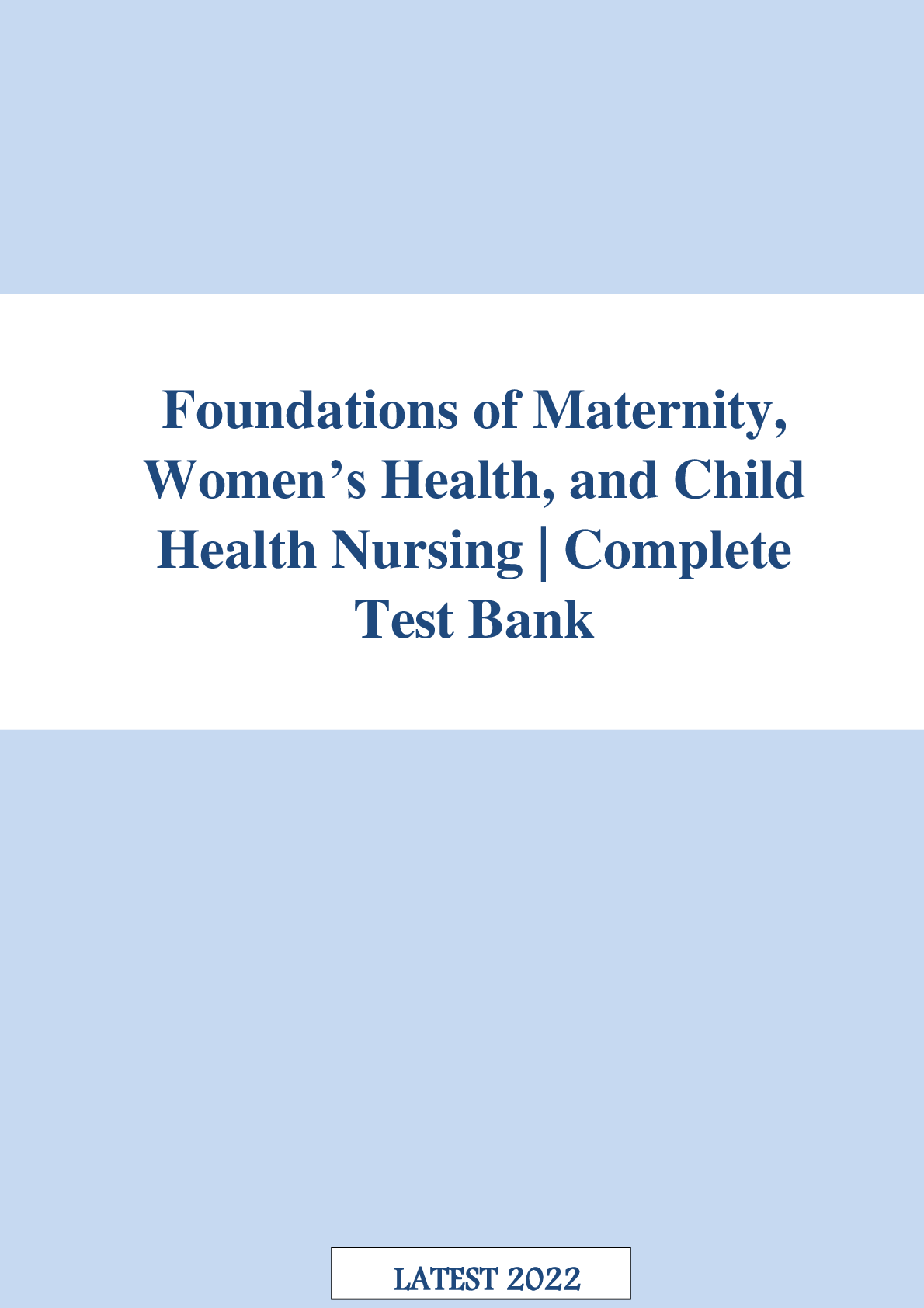
Buy this document to get the full access instantly
Instant Download Access after purchase
Add to cartInstant download
Reviews( 0 )
Document information
Connected school, study & course
About the document
Uploaded On
Sep 02, 2022
Number of pages
722
Written in
Additional information
This document has been written for:
Uploaded
Sep 02, 2022
Downloads
0
Views
69


.png)

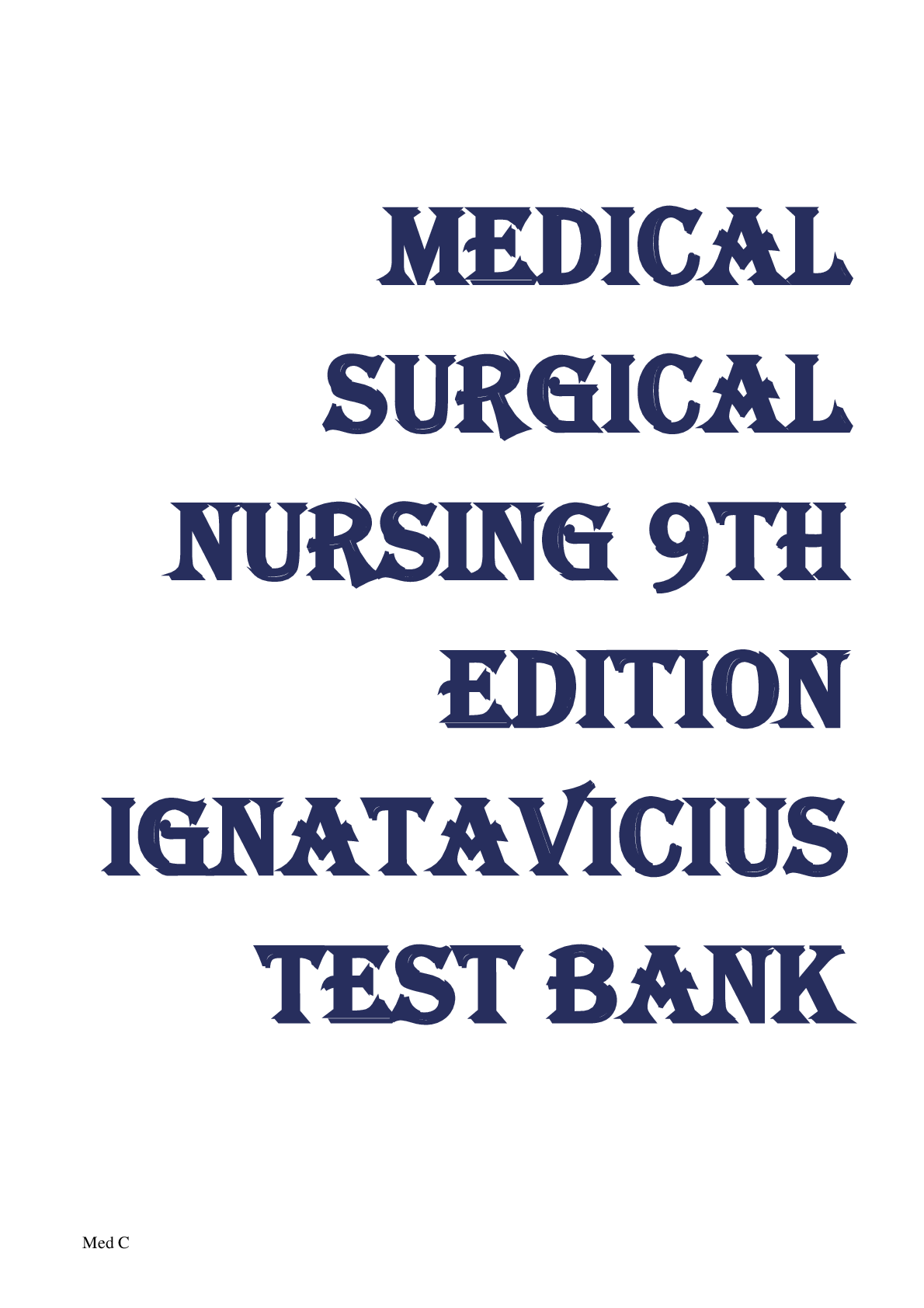

.png)
.png)
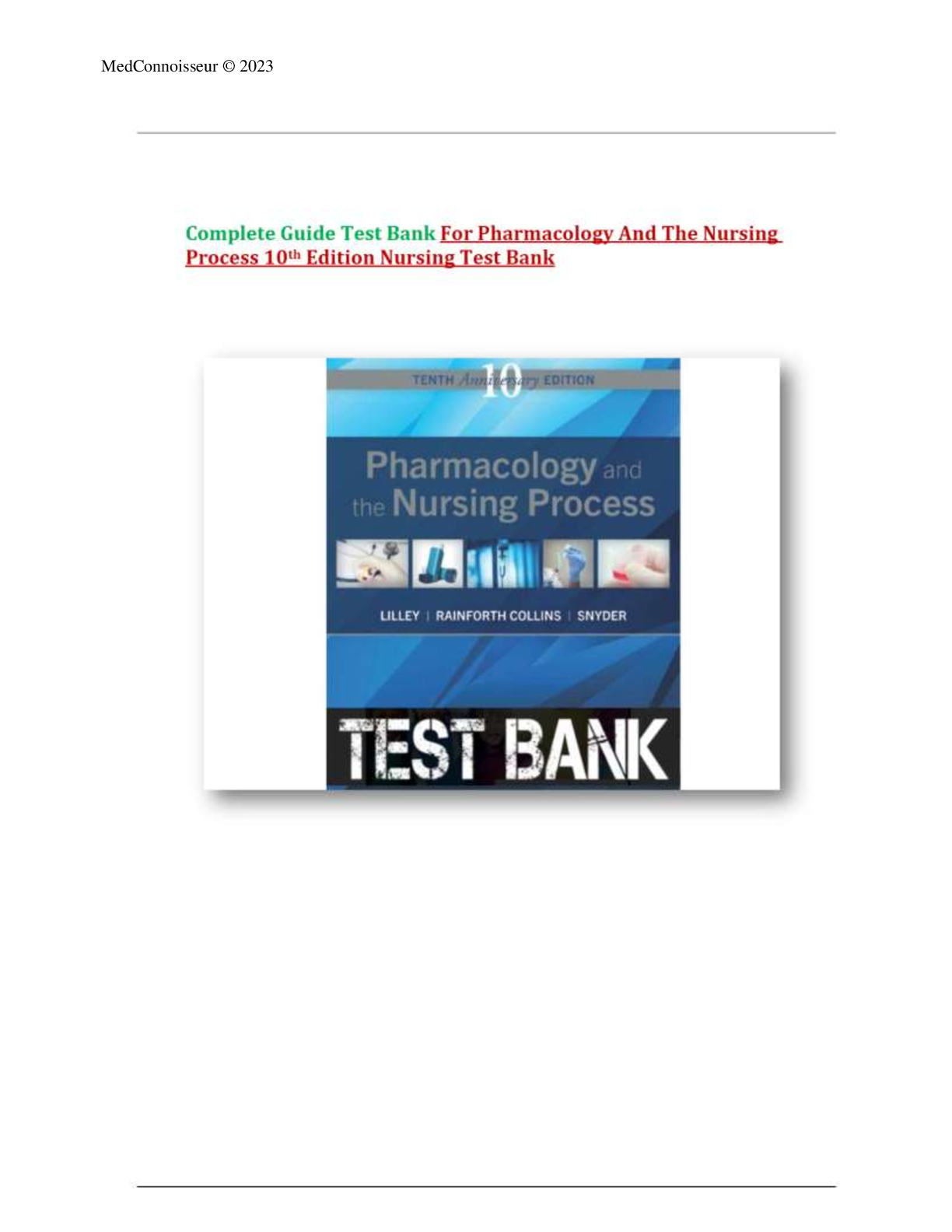

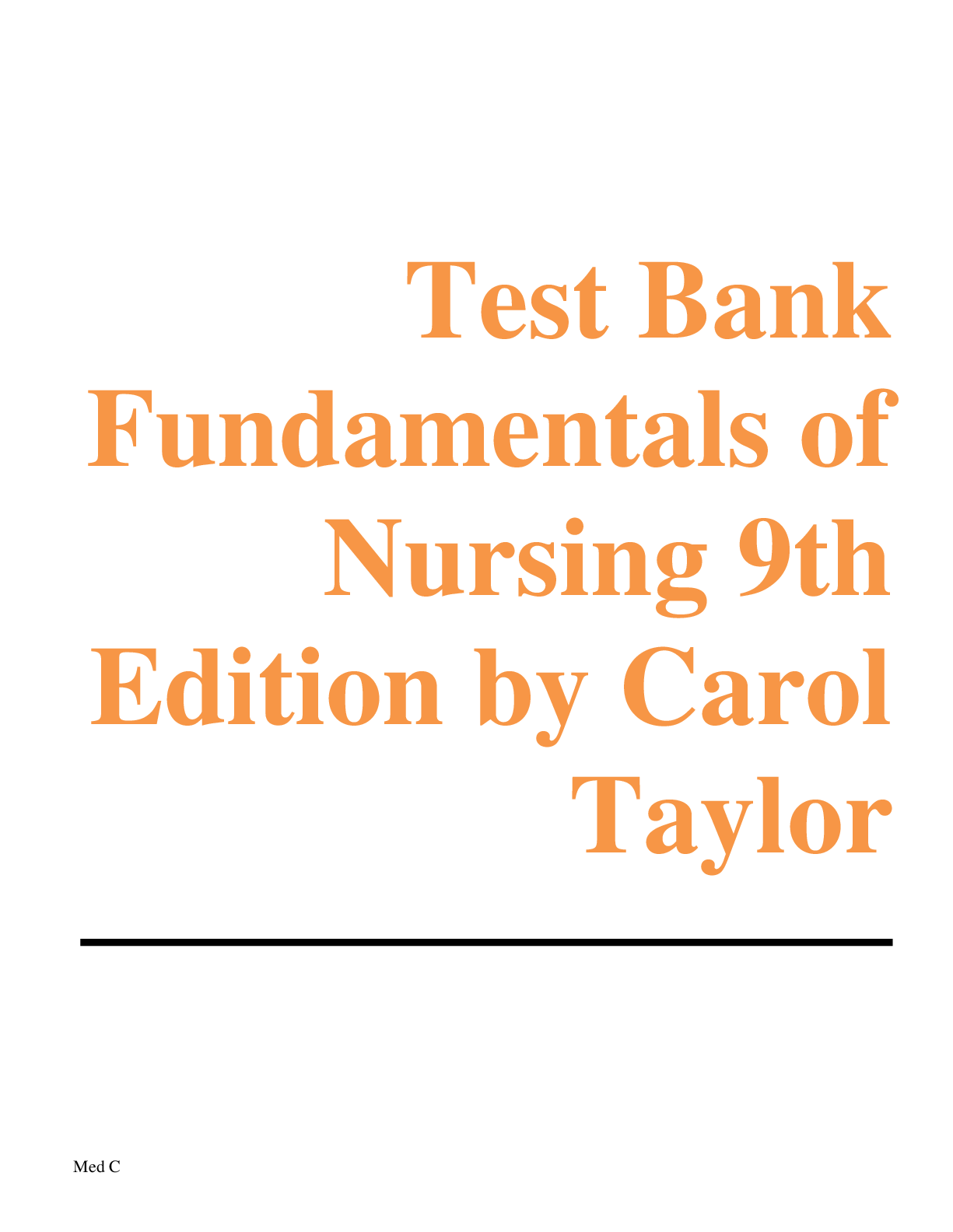

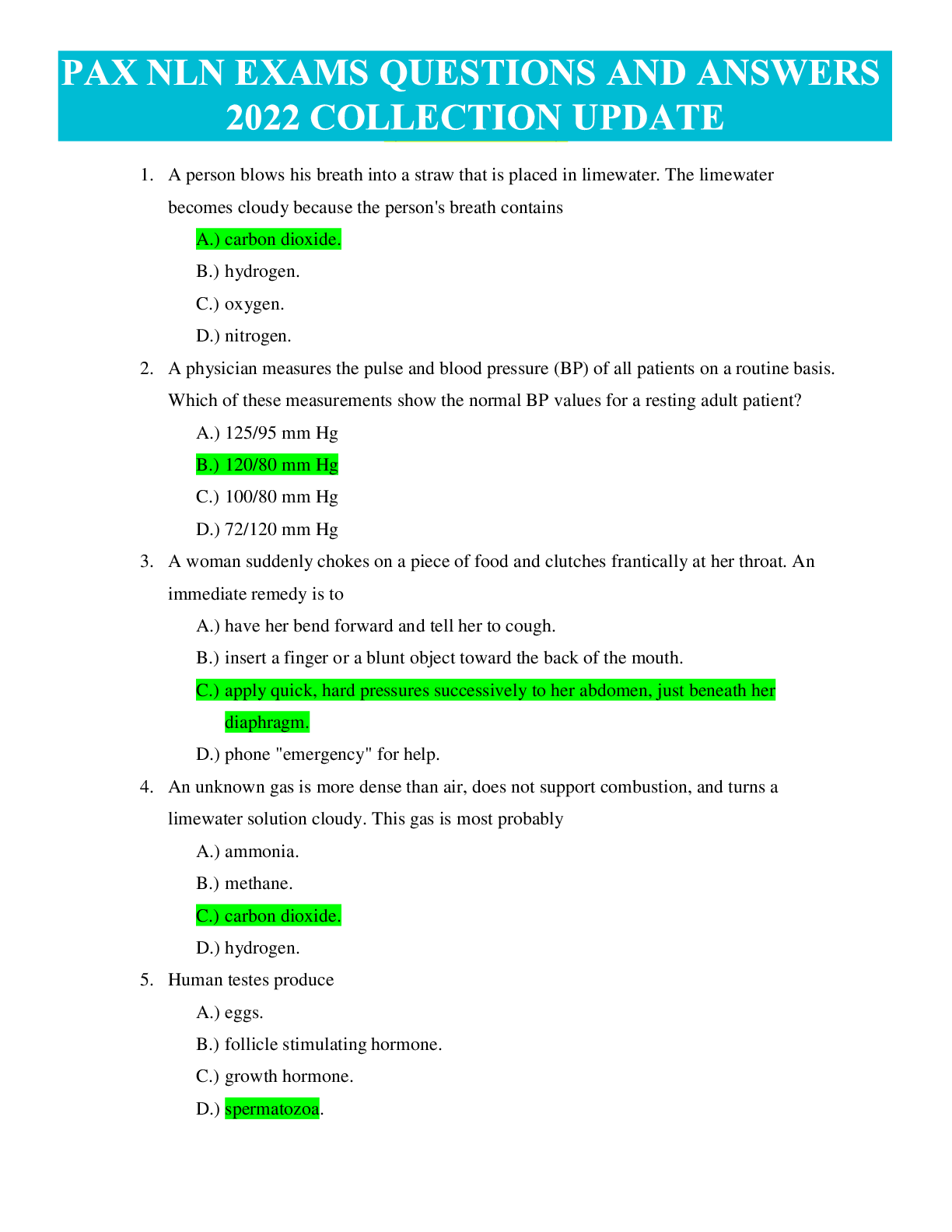
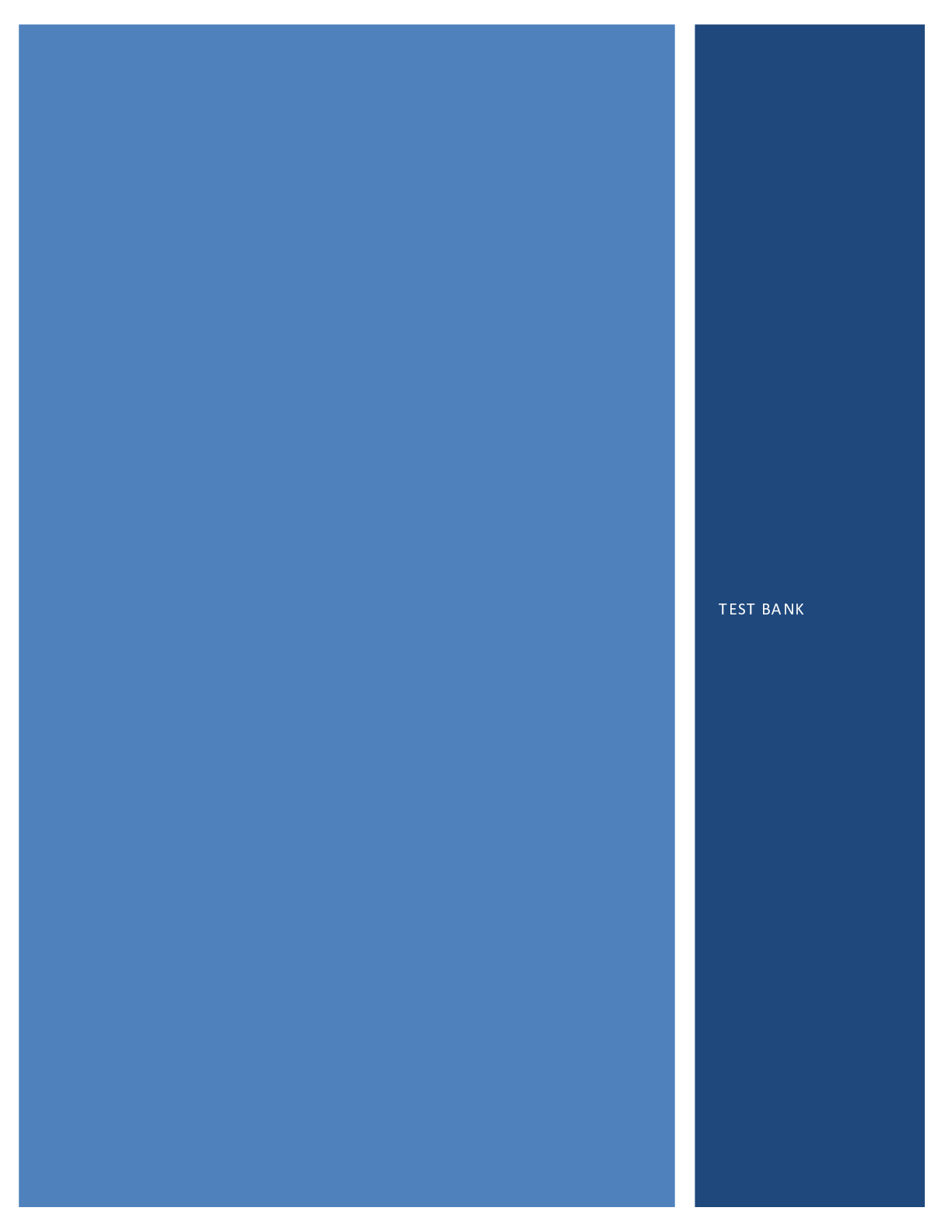

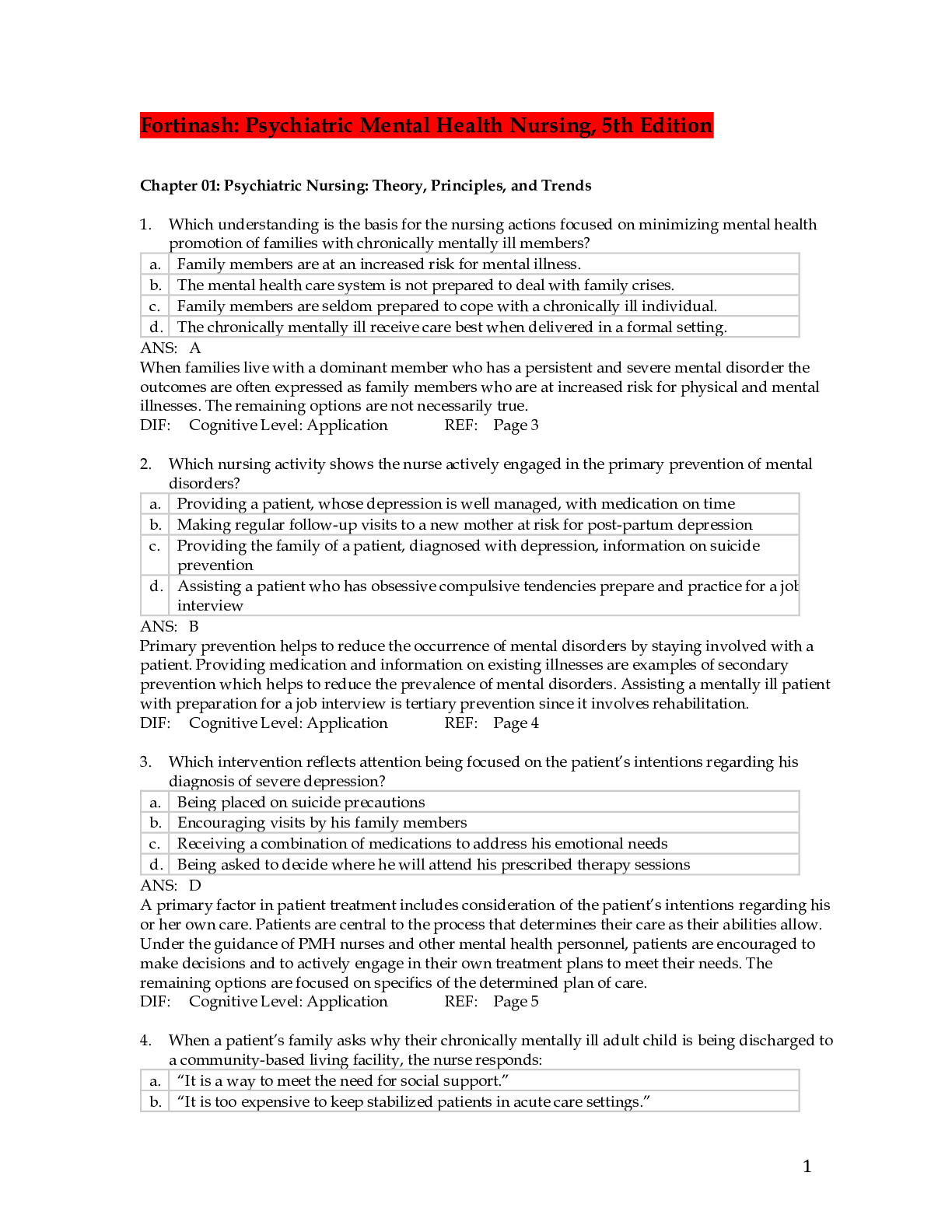


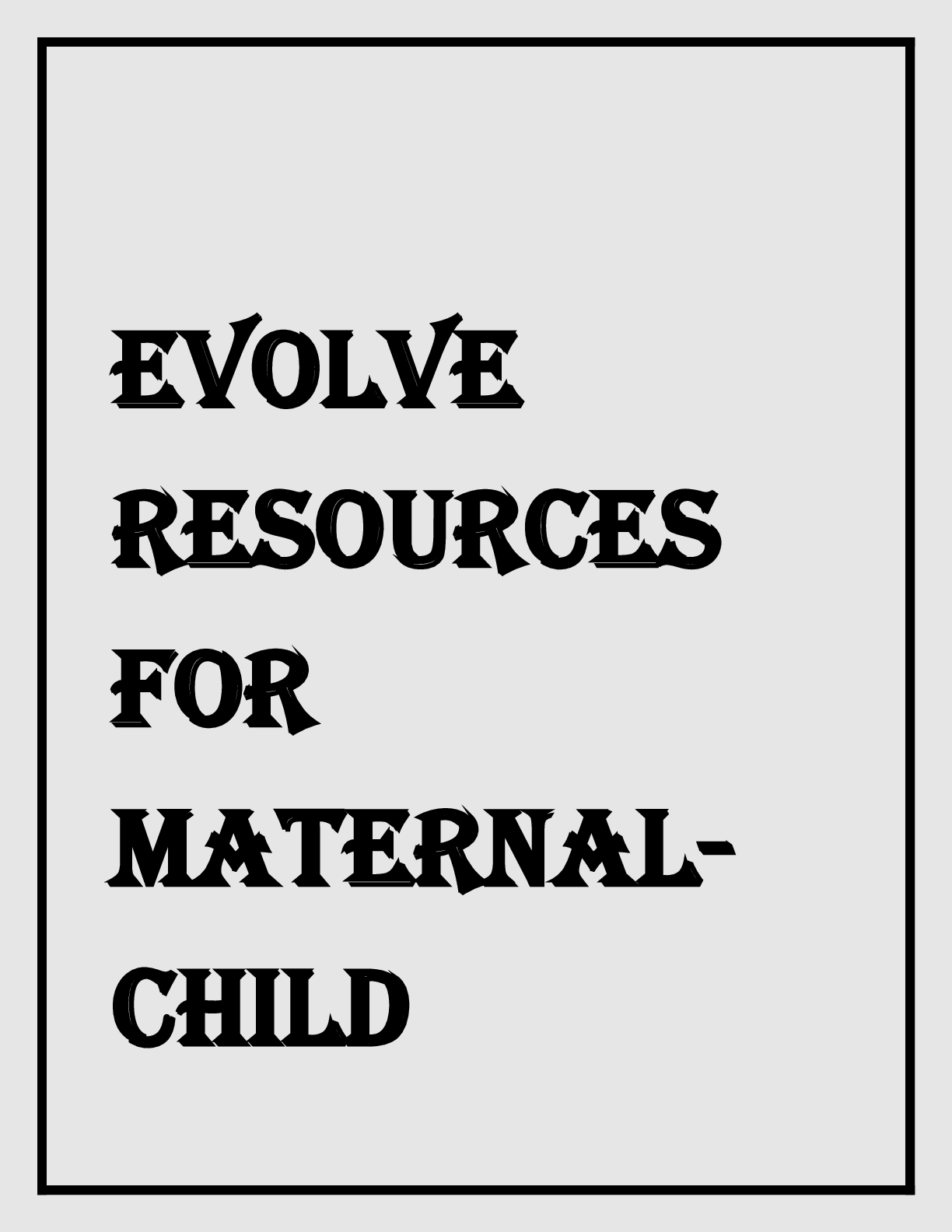

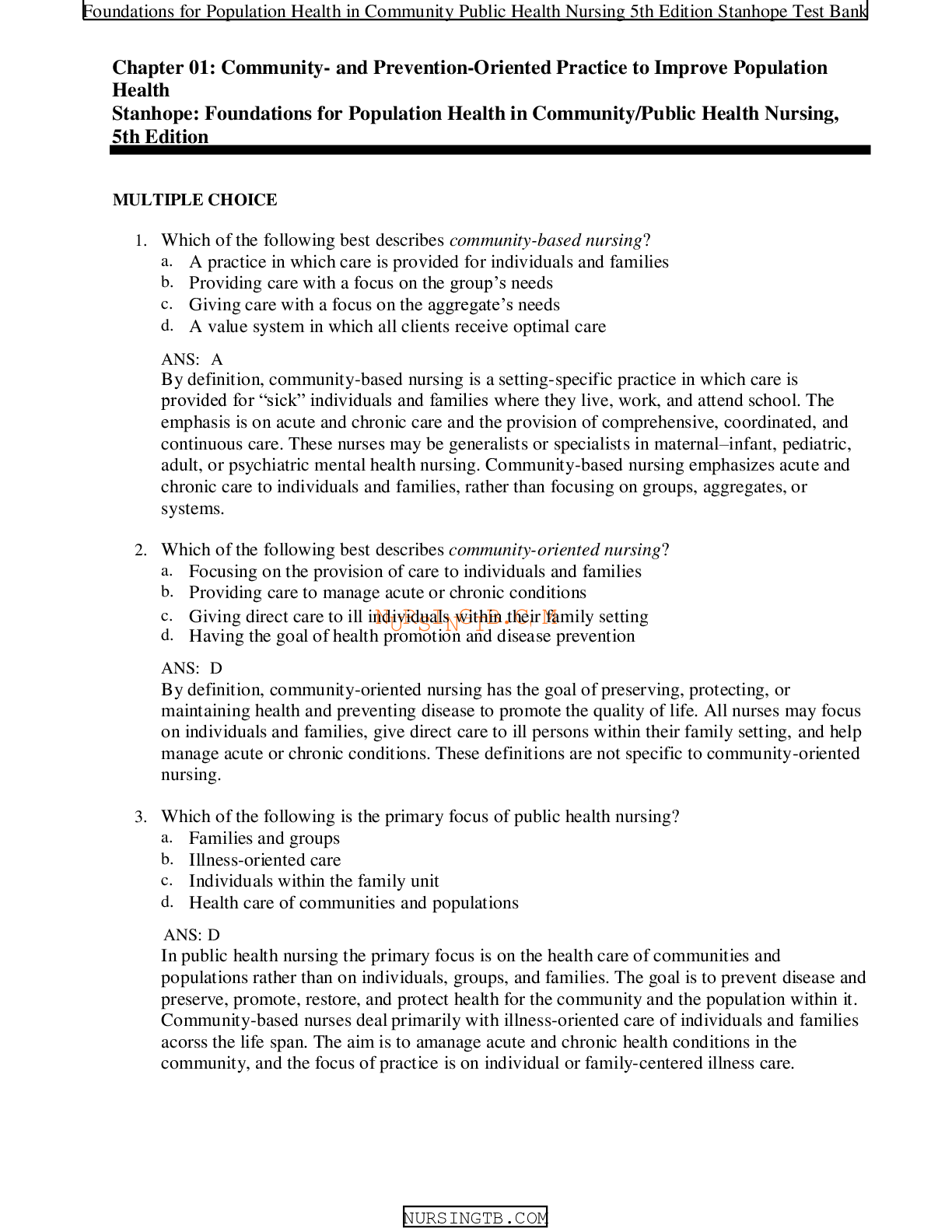
.png)


